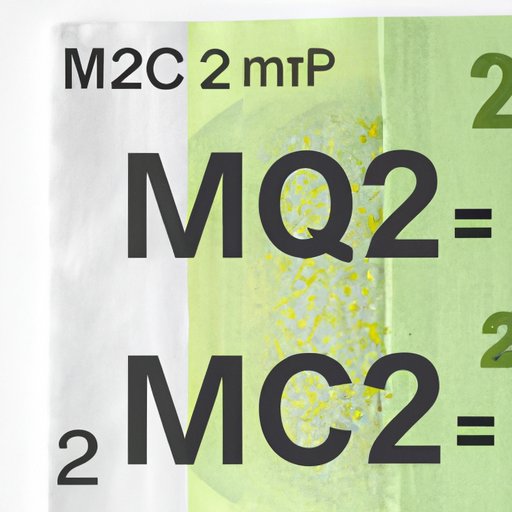
Introduction
Money supply is a critical economic indicator that measures the total amount of money circulating in the economy. M2 Money, also known as the broad money supply, is one of the measures that policymakers use to gauge the health of an economy and determine its monetary policy. In this article, we will explore what M2 Money is, how it is calculated, and its role in the economy. We will also discuss the differences between M1 and M2 Money supply and how changes in M2 Money can affect interest and inflation rates. By the end of this article, readers will understand the significance of M2 Money and its trends, enabling them to make informed decisions in the economic landscape.

M2 Money: A Comprehensive Explanation of Its Definition and Components
M2 Money is a measure of the money supply that includes all the components of M1 Money (cash, demand deposits, and traveler’s checks) while also incorporating other liquid assets such as savings deposits, money market funds, and short-term time deposits. In other words, M2 Money represents the money supply that is readily available for spending and investment.
Components of M2 Money
M2 Money is made up of several components, including M1 Money and the following:
– Savings deposits – Money held in a savings account that can be withdrawn at any time.
– Money market funds – Mutual funds that invest in highly liquid, short-term debt securities
– Short-term time deposits – Deposits that mature within one year
All of these assets are considered liquid since they can be easily converted into cash or used to purchase goods and services.
How M2 Money is Calculated
The Federal Reserve uses a formula to calculate M2 Money supply by adding the following:
– M1 Money
– Savings deposits
– Money market funds
– Short-term time deposits under $100,000
– Institutional money market funds
On the other hand, M1 Money supply is calculated by adding the following:
– Cash
– Demand deposits
– Traveler’s checks
Understanding M2 Money: Its Importance in Macroeconomics and Monetary Policy
M2 Money plays a crucial role in guiding monetary policy and macroeconomic analysis. The Federal Reserve uses M2 Money to determine the optimal money supply to control inflation and sustain economic growth. Macroeconomists use M2 Money to measure the money supply’s impact on the economy and predict future trends.
The Role M2 Money Plays in Macroeconomics and Monetary Policy
M2 Money is a measure of the money supply that reflects the total amount of money that is available to individuals and firms for use. It is a crucial indicator that economists and policymakers use to track the overall economic health of a country. Aggregate demand, which represents the total demand for goods and services in the economy, depends on the money supply available in the economy. Policymakers use M2 Money to guide monetary policy, i.e., the actions taken by the central bank to control the money supply and interest rates in the economy.
How M2 Money Affects the Economy on a Broader Scale
M2 Money affects the economy on a broader scale by influencing consumption, investment, and overall economic growth. When M2 Money increases, it creates liquidity in the financial system, stimulating economic activity, and fostering growth. An increase in M2 Money can lead to lower interest rates and higher disposable income, which encourages consumers to spend more. This, in turn, can lead to increased investment and job creation.
On the other hand, a decrease in M2 Money supply can slow down the economy by raising interest rates, which discourages borrowing and leads to decreased spending and investment.
The Role of M2 Money in Measuring the Health of the US Economy
M2 Money is an essential indicator of the health of the US economy. Since M2 Money measures the entire liquid money supply, it reflects the total demand for goods and services. Consequently, it provides insight into the future direction and health of the economy.
How M2 Money is Used to Measure the Health of the US Economy
The Federal Reserve and other policymakers use M2 Money to gauge economic activity’s strength and assess a country’s economic health. The velocity of money, which measures the frequency at which money circulates in the economy, is calculated by dividing the gross domestic product (GDP) by the M2 Money supply. When this ratio is high, it signals that the money is being spent frequently, which suggests a healthy economy.
The Significance of M2 Money in Economic Indicators
M2 Money is included in several economic indicators that measure the overall economic health. These indicators include the fiscal deficit, gross domestic product, and the Consumer Price Index. A high M2 Money supply, for instance, can increase the inflation rate, which can cause prices to rise, making it more expensive for consumers to purchase goods and services.
Exploring the Differences between M1 and M2 Money Supply
M1 and M2 are two critical measures of the money supply that policymakers use to monitor economic activity. Though both M1 and M2 Money include cash, demand deposits, and traveler’s checks, they differ in several respects.
Comparing and Contrasting M1 and M2 Money Supply
M1 Money includes only the most liquid forms of money, such as cash and demand deposits, while M2 Money incorporates less liquid forms of money like savings deposits, money market funds, and short-term deposits. M2 Money is thought to be a more comprehensive measure of the money supply since it tracks more assets.
Moreover, M2 Money is a better gauge of economic activity than M1 Money as it reflects the total demand for goods and services. It distinguishes more between liquid and less liquid assets, providing valuable information on the economic health of a country.
How M2 Money Affects Interest Rates and Inflation Rates
M2 Money supply has a significant impact on both interest rates and inflation rates. Policymakers use M2 Money to guide monetary policy and manage inflation by manipulating interest rates to incentivize borrowing and spending.
How Changes in M2 Money Supply can Affect Interest Rates
When the Federal Reserve increases M2 Money supply, it creates more liquidity in the financial system, which typically leads to lower interest rates. The opposite is the case when the Federal Reserve decreases M2 Money supply, leading to higher interest rates. A fall in M2 Money supply reduces liquidity in the financial markets and raises interest rates, discouraging borrowing and dampening economic activity.
How M2 Money Supply is Linked to Inflation Rates
Inflation occurs when there is too much money chasing too few goods and services. When M2 Money supply increases, this increases the money supply, causing demand to outstrip supply. This rise in demand leads to higher prices and subsequently, inflation. Therefore, policymakers use M2 Money to manage inflation and maintain price stability in the economy.
M2 Money: Analyzing the Trends and Predicting Future Changes
Analyzing trends in M2 Money is vital to understand the current economic climate and make informed decisions. By tracking the changes in M2 Money over time, economists can predict how it will shift in the future and its potential impact on the economy.
Analyzing Current Trends in M2 Money Supply
For the past few years, M2 Money supply has been increasing at a rate of approximately 8% annually. This growth is due to increased consumer spending, corporate investment, and government spending.
Predictions About Future Changes to M2 Money Supply
Economists’ predictions about future M2 Money supply changes are mixed, given the current uncertainties surrounding the economy. The COVID-19 pandemic’s uncertainty has created changes in the money supply and economic growth. However, the overall trend towards an increase in M2 Money supply is expected to continue, with policymakers likely to use expansionary monetary policies to stimulate economic growth.
Conclusion
M2 Money is a critical measure of the money supply that reflects the liquid assets available for spending and investment. It plays a vital role in guiding macroeconomic analysis and monetary policy. M2 Money helps policymakers measure the strength of a country’s economy, predict future trends, and gauge the impact of policy decisions on the economy. Understanding M2 Money’s role and trends is vital to making informed decisions that impact financial planning and investment decisions, among others. By tracking these trends and applying them to personal or business decisions, individuals can navigate economic factors confidently in the marketplace.





